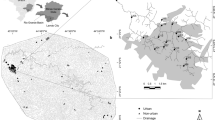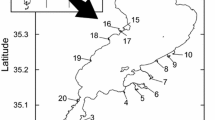Abstract
Freshwater ecosystems are under threat from habitat loss, partly due to urban expansion. However, some elements of urban freshwaters are already integral parts of the urban landscape and so are more resilient to loss, representing opportunities for the enhancement of freshwater resources within cities. This study investigated the biodiversity value of the Leeds-Liverpool Canal in Leeds, UK, in relation to its landscape context. Specifically, we tested the hypotheses that (i) biodiversity value is lowest nearest to the urban core, and (ii) the pattern of canal locks structured ecological communities. Nutrients, metals and dissolved carbon all existed at relatively low concentrations, contrary to what is often seen in urban water bodies, although concentrations were higher in the urban core. This gradient of chemical stress was associated with a decline in macroinvertebrate diversity towards the city centre, which manifested as pollution-sensitive taxa being excluded from this area. Community structures were found to vary between groups of sampling sites separated by locks, suggesting that locks may act as barriers for aquatic invertebrates by restricting dispersal. The results in this study indicate that canals in urban areas can be high-quality habitats, despite the associated anthropogenic stressors, and locks may represent a unique model for researching relationships between connectivity and community structure.




Similar content being viewed by others
References
Bilton DT, Freeland JR, Okamura B (2001) Dispersal in freshwater invertebrates. Annu Rev Ecol Syst 32:159–181
Boets P, Lock K, Goethals PL (2011) Using long-term monitoring to investigate the changes in species composition in the harbour of Ghent (Belgium). Hydrobiologia 6631:55–166
Bornette G, Amoros C, Lamouroux N (1998) Aquatic plant diversity in riverine wetlands: the role of connectivity. Freshw Biol 39:267–283
Brand AB, Snodgrass JW (2010) Value of artificial habitats for amphibian reproduction in altered landscapes. Conserv Biol 24:295–301
Buss DF, Baptista DF, Silveira MP, Nessimian JL, Dorvillé LF (2002) Influence of water chemistry and environmental degradation on macroinvertebrate assemblages in a river basin in south-East Brazil. Hydrobiologia 481:125–136
Chester ET, Robson BJ (2013) Anthropogenic refuges for freshwater biodiversity: their ecological characteristics and management. Biol Conserv 166:64–75
Cohen B (2006) Urbanization in developing countries: current trends, future projections, and key challenges for sustainability. Technol Soc 28:63–80
Costanza R, d'Arge R, De Groot R, Farber S, Grasso M, Hannon B, Limburg K, Naeem S, O'neill RV, Paruelo J, Raskin RG (1997) The value of the world's ecosystem services and natural capital. Nature 387:253–260
Cottenie K, Nuytten N, Michels E, De Meester L (2001) Zooplankton community structure and environmental conditions in a set of interconnected ponds. Hydrobiologia 442:339–350
Dallimer M, Irvine KN, Skinner AM, Davies ZG, Rouquette JR, Maltby LL, Warren PH, Armsworth PR, Gaston KJ (2012) Biodiversity and the feel-good factor: understanding associations between self-reported human well-being and species richness. BioScience 62:47–55
Davies B, Biggs J, Williams P, Whitfield M, Nicolet P, Sear D, Bray S, Maund S (2008) Comparative biodiversity of aquatic habitats in the European agricultural landscape. Agric Ecosyst Environ 125:1–8
Davis AP, Shokouhian M, Ni S (2001) Loading estimates of lead, copper, cadmium, and zinc in urban runoff from specific sources. Chemosphere 44:997–1009
Dobson M, Pawley S, Fletcher M, Powell A (2012) Guide to freshwater invertebrates. The Freshwater Biological Association, Ambleside, UK
Dudgeon D, Arthington AH, Gessner MO, Kawabata ZI, Knowler DJ, Lévêque C, Naiman RJ, Prieur-Richard AH, Soto D, Stiassny ML, Sullivan CA (2006) Freshwater biodiversity: importance, threats, status and conservation challenges. Biol Rev 81:163–182
European Environment Agency (2017) https://www.eea.europa.eu/themes/water/intro.
Finlay BJ (2002) Global dispersal of free-living microbial eukaryote species. Science 296:1061–1063
Fortuna MA, Gómez-Rodríguez C, Bascompte J (2006) Spatial network structure and amphibian persistence in stochastic environments. P Roy Soc B-Biol Sci 273:1429–1434
Gallardo B, García M, Cabezas Á, González E, González M, Ciancarelli C, Comín FA (2008) Macroinvertebrate patterns along environmental gradients and hydrological connectivity within a regulated river-floodplain. Aquat Sci 70:248–258
Garden JG, McAlpine CA, Possingham HP (2010) Multi-scaled habitat considerations for conserving urban biodiversity: native reptiles and small mammals in Brisbane, Australia. Landsc Ecol 25:1013–1028
Gasith A, Resh VH (1999) Streams in Mediterranean climate regions: abiotic influences and biotic responses to predictable seasonal events. Annu Rev Ecol Syst 30:51–81
Gessner MO, Inchausti P, Persson L, Raffaelli DG, Giller PS (2004) Biodiversity effects on ecosystem functioning: insights from aquatic systems. Oikos 104:419–422
Godfrey PJ (1978) Diversity as a measure of benthic macroinvertebrate community response to water pollution. Hydrobiologia 57:111–122
Haase P, Hering D, Jähnig SC, Lorenz AW, Sundermann A (2013) The impact of hydromorphological restoration on river ecological status: a comparison of fish, benthic invertebrates, and macrophytes. Hydrobiologia 704:475–488
Harrell FE Jr, with contributions from Charles Dupont and many others (2019) Hmisc: Harrell Miscellaneous. R package version 4.2–0. https://CRAN.R-project.org/package=Hmisc
Hassall C (2014) The ecology and biodiversity of urban ponds. WIREs Water 1:187–206
Heino J (2000) Lentic macroinvertebrate assemblage structure along gradients in spatial heterogeneity, habitat size and water chemistry. Hydrobiologia 418:229–242
Hill MJ, Biggs J, Thornhill I, Briers RA, Gledhill DG, White JC, Wood PJ, Hassall C (2017) Urban ponds as an aquatic biodiversity resource in modified landscapes. Glob Change Bio 23:986–999
Hirst H, Jüttner I, Ormerod SJ (2002) Comparing the responses of diatoms and macro-invertebrates to metals in upland streams of Wales and Cornwall. Freshw Biol 47:1752–1765
Hooper DU, Chapin FS, Ewel JJ, Hector A, Inchausti P, Lavorel S, Lawton JH, Lodge DM, Loreau M, Naeem S, Schmid B (2005) Effects of biodiversity on ecosystem functioning: a consensus of current knowledge. Ecol Monogr 75:3–35
Jarvie HP, Haygarth PM, Neal C, Butler P, Smith B, Naden PS, Joynes A, Neal M, Wickham H, Armstrong L, Harman S, Palmer-Felgate EJ (2008) Stream water chemistry and quality along an upland-lowland rural land-use continuum, south west England. J Hydrol 350:215–231
Kelly LA, Hassall C (2018) The spatial ecology of phytoplankton blooms in UK canals. Inland Waters 8:422–433
Kowarik I (2011) Novel urban ecosystems, biodiversity, and conservation. Environ Pollut 159:1974–1983
Leuven RS, van der Velde G, Baijens I, Snijders J, van der Zwart C, Lenders HR, de Vaate A b (2009) The river Rhine: a global highway for dispersal of aquatic invasive species. Biol Invasions 11:1989
Liddle MJ, Scorgie HRA (1980) The effects of recreation on freshwater plants and animals: a review. Biol Conserv 17:183–206
Lundberg JG, Kottelat M, Smith GR, Stiassny ML, Gill AC (2000) So many fishes, so little time: an overview of recent ichthyological discovery in continental waters. Ann Mo Bot Gard 87:26–62
McKinney ML (2006) Urbanization as a major cause of biotic homogenization. Biol Conserv 127:247–260
Medupin C (2019) Distribution of benthic macroinvertebrate communities and assessment of water quality in a small UK river catchment. SN Applied Sciences 1:544
Medupin C (2020) Spatial and temporal variation of benthic macroinvertebrate communities along an urban river in greater Manchester, UK. Environ Monit Assess 192:84
Moore AA, Palmer MA (2005) Invertebrate biodiversity in agricultural and urban headwater streams: implications for conservation and management. Ecol Appl 15:1169–1177
Natural England (2013) Sites of special scientific interest: managing your land. http://gov.uk/guidance/protected-areas-sites-of-special-scientific-interest. Accessed 24th May 2020
Neal C, Jarvie HP, Neal M, Love AJ, Hill L, Wickham H (2005) Water quality of treated sewage effluent in a rural area of the upper Thames Basin, southern England, and the impacts of such effluents on riverine phosphorus concentrations. J Hydrol 304:103–1177
Oksanen J, Blanchet FG, Friendly M, Kindt R, Legendre P, McGlinn D, Minchin PR, O'Hara RB, Simpson GL, Solymos P, Stevens MHH, Szoecs E, Wagner H (2019) Vegan: community ecology package. R package version 2:5–5 https://CRAN.R-project.org/package=vegan
Paisley MF, Trigg DJ, Walley WJ (2014) Revision of the biological monitoring working party (bmwp) score system: derivation of present-only and abundance-related scores from field data. River Res Appl 30:887–904
Paul MJ, Meyer JL (2001) Streams in the urban landscape. Annu Rev Ecol Syst 32:333–365
Pimentel D (2005) Aquatic nuisance species in the New York State Canal and Hudson River systems and the Great Lakes Basin: an economic and environmental assessment. Environ Manag 35:692–702
Pimentel D, Wilson C, McCullum C, Huang R, Dwen P, Flack J, Tran Q, Saltman T, Cliff B (1997) Economic and environmental benefits of biodiversity. BioScience 47:747–757
R Core Team (2018) R: A language and environment for statistical computing. R Foundation for Statistical Computing, Vienna, Austria. URL: https://www.R-project.org/
Riley SP, Busteed GT, Kats LB, Vandergon TL, Lee LF, Dagit RG, Kerby JL, Fisher RN, Sauvajot RM (2005) Effects of urbanization on the distribution and abundance of amphibians and invasive species in southern California streams. Conserv Biol 19:1894–1907
Rothwell JJ, Dise NB, Taylor KG, Allott TEH, Scholefield P, Davies H, Neal C (2010) A spatial and seasonal assessment of river water chemistry across north West England. Sci Total Environ 408:841–855
Sala OE, Chapin FS, Armesto JJ, Berlow E, Bloomfield J, Dirzo R, Huber-Sanwald E, Huenneke LF, Jackson RB, Kinzig A, Leemans R (2000) Global biodiversity scenarios for the year 2100. Science 287:1770–1774
Santoro A, Blo G, Mastrolitti S, Fagioli F (2009) Bioaccumulation of heavy metals by aquatic macroinvertebrates along the Basento River in the south of Italy. Water Air Soil Poll 201:19–31
Schlosser IJ, Karr JR (1981) Riparian vegetation and channel morphology impact on spatial patterns of water quality in agricultural watersheds. Environ Manag 5:233–243
Seto KC, Güneralp B, Hutyra LR (2012) Global forecasts of urban expansion to 2030 and direct impacts on biodiversity and carbon pools. P Natl Acad Sci USA 109:16083–16088
Shannon CE (1948) A mathematical theory of communication. Bell Syst Tech J 27:379–423
Sheldon F, Boulton AJ, Puckridge JT (2002) Conservation value of variable connectivity: aquatic invertebrate assemblages of channel and floodplain habitats of a central Australian arid-zone river, Cooper Creek. Biol Conserv 103:13–31
Smolders AJP, Lock RAC, Van der Velde G, Hoyos RM, Roelofs JGM (2003) Effects of mining activities on heavy metal concentrations in water, sediment, and macroinvertebrates in different reaches of the Pilcomayo River, South America. Arch Environ Con Tox 44:314–323
Valera CA, Pissarra TCT, Valle Júnior RFD, Oliveira CF, Moura JP, Sanches Fernandes LF, Pacheco FAL (2019) The buffer capacity of riparian vegetation to control water quality in anthropogenic catchments from a legally protected area: a critical view over the Brazilian new forest code. Water 11:549
Vanschoenwinkel B, Gielen S, Vandewaerde H, Seaman M, Brendonck L (2008) Relative importance of different dispersal vectors for small aquatic invertebrates in a rock pool metacommunity. Ecography 31:567–577
Vermonden K, Leuven RS, van der Velde G, van Katwijk MM, Roelofs JG, Hendriks AJ (2009) Urban drainage systems: an undervalued habitat for aquatic macroinvertebrates. Biol Conserv 142:1105–1115
Vos AT, Roos JC (2005) Causes and consequences of algal blooms in loch Logan, an urban impoundment. Water SA 31:385–392
York AM, Shrestha M, Boone CG, Zhang S, Harrington JA, Prebyl TJ, Swann A, Agar M, Antolin MF, Nolen B, Wright JB (2011) Land fragmentation under rapid urbanization: a cross-site analysis of southwestern cities. Urban Ecosyst 14:429–455
Zimmer KD, Hanson MA, Butler MG (2000) Factors influencing invertebrate communities in prairie wetlands: a multivariate approach. Can J Fish Aquat Sci 57:76–85
Acknowledgements
The authors would like to thank the Canal & River Trust for giving permission to carry out the fieldwork for this study and for providing information on the Leeds-Liverpool Canal.
Author information
Authors and Affiliations
Corresponding author
Electronic supplementary material
ESM 1
(DOCX 43 kb)
Rights and permissions
About this article
Cite this article
Walker, J.R., Hassall, C. The effects of water chemistry and lock-mediated connectivity on macroinvertebrate diversity and community structure in a canal in northern England. Urban Ecosyst 24, 491–500 (2021). https://doi.org/10.1007/s11252-020-01053-8
Published:
Issue Date:
DOI: https://doi.org/10.1007/s11252-020-01053-8




